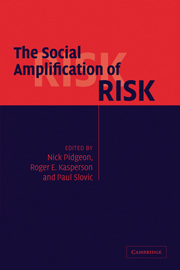Book contents
- Frontmatter
- Contents
- List of figures
- List of tables
- List of contributors
- Acknowledgments
- Introduction
- Part I Conceptual foundations
- 1 The social amplification of risk: assessing fifteen years of research and theory
- 2 The logical structure of the social amplification of risk framework (SARF): Metatheoretical foundations and policy implications
- 3 Social amplification of risk and the layering method
- 4 Institutional failure and the organizational amplification of risks: the need for a closer look
- Part II Risk signals and the mass media
- Part III Public perceptions and social controversy
- Part IV Risk ripples and stigma effects
- Part V Policy and management
- Bibliography
- Index
2 - The logical structure of the social amplification of risk framework (SARF): Metatheoretical foundations and policy implications
Published online by Cambridge University Press: 06 July 2010
- Frontmatter
- Contents
- List of figures
- List of tables
- List of contributors
- Acknowledgments
- Introduction
- Part I Conceptual foundations
- 1 The social amplification of risk: assessing fifteen years of research and theory
- 2 The logical structure of the social amplification of risk framework (SARF): Metatheoretical foundations and policy implications
- 3 Social amplification of risk and the layering method
- 4 Institutional failure and the organizational amplification of risks: the need for a closer look
- Part II Risk signals and the mass media
- Part III Public perceptions and social controversy
- Part IV Risk ripples and stigma effects
- Part V Policy and management
- Bibliography
- Index
Summary
The social amplification of risk framework (SARF) is the most comprehensive tool available for the study of risk. Theories and frameworks are useful and effective only insofar as they conform to certain fundamental features of logic: clearly defined terms, coherence, internal consistency, sound organization explicated with parsimony, accompanied by a specification of scope conditions, and the generation of testable hypotheses. The first goal of this chapter is to evaluate critically key foundational concepts of the SARF and to strengthen its foundation with a set of metatheoretical principles that have been coherently structured. The second goal is to use these same metatheoretical principles to establish symmetry between SARF and risk policy. Such symmetry should enhance communication between experts and laypersons in the development of risk policy and, therefore, remove some of the obstacles to effective, democratic risk policy.
Genesis of the social amplification of risk framework
The SARF developed in the late 1980s in response to the emergence of multiple perspectives in the rapidly growing risk literature. The multiple perspectives that emerged led, according to Kasperson (1992) one of the leading architects of the SARF, to key disjunctures which came to dominate the field: disjunctures between technical and social analyses of risk; disjunctures within the social sciences themselves (e.g. between the rational actor perspective (RAP) of economics and engineering and the psychometric paradigm; see also Jaeger et al. 2001); disjunctures between the older natural hazards social science and the newer technological hazard social sciences; and disjunctures over scientific and other claims to knowledge.
- Type
- Chapter
- Information
- The Social Amplification of Risk , pp. 47 - 79Publisher: Cambridge University PressPrint publication year: 2003
- 114
- Cited by



